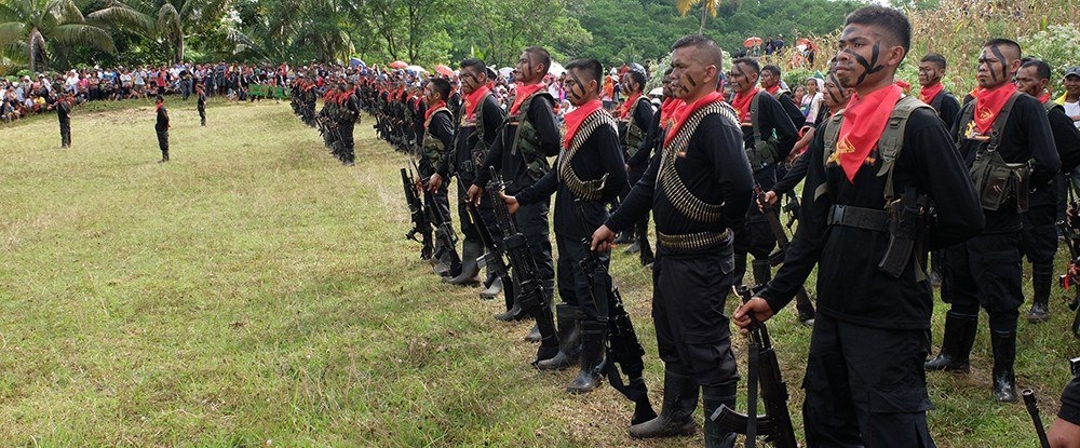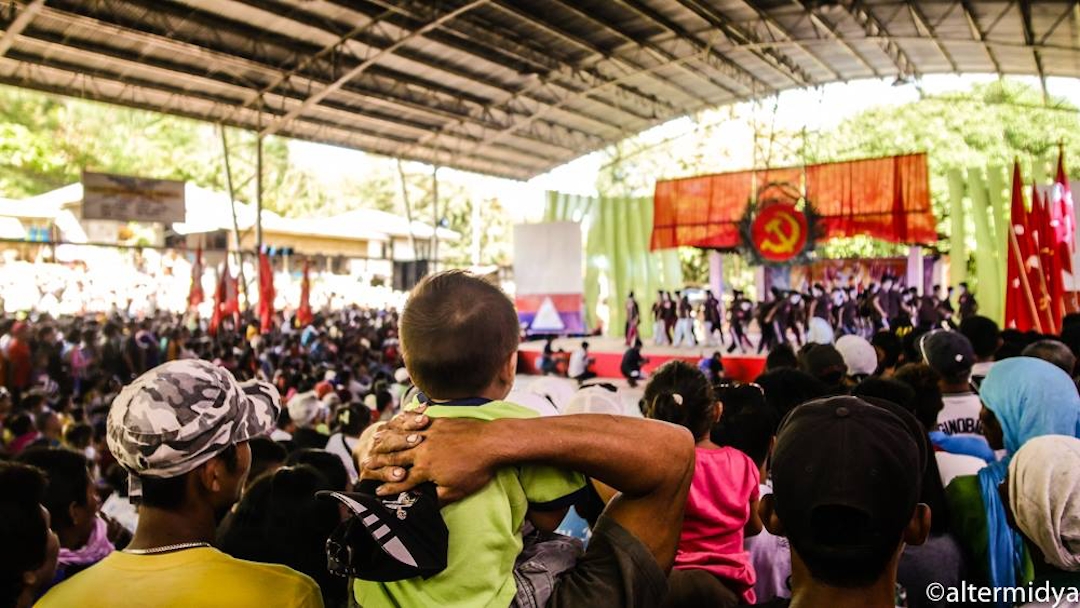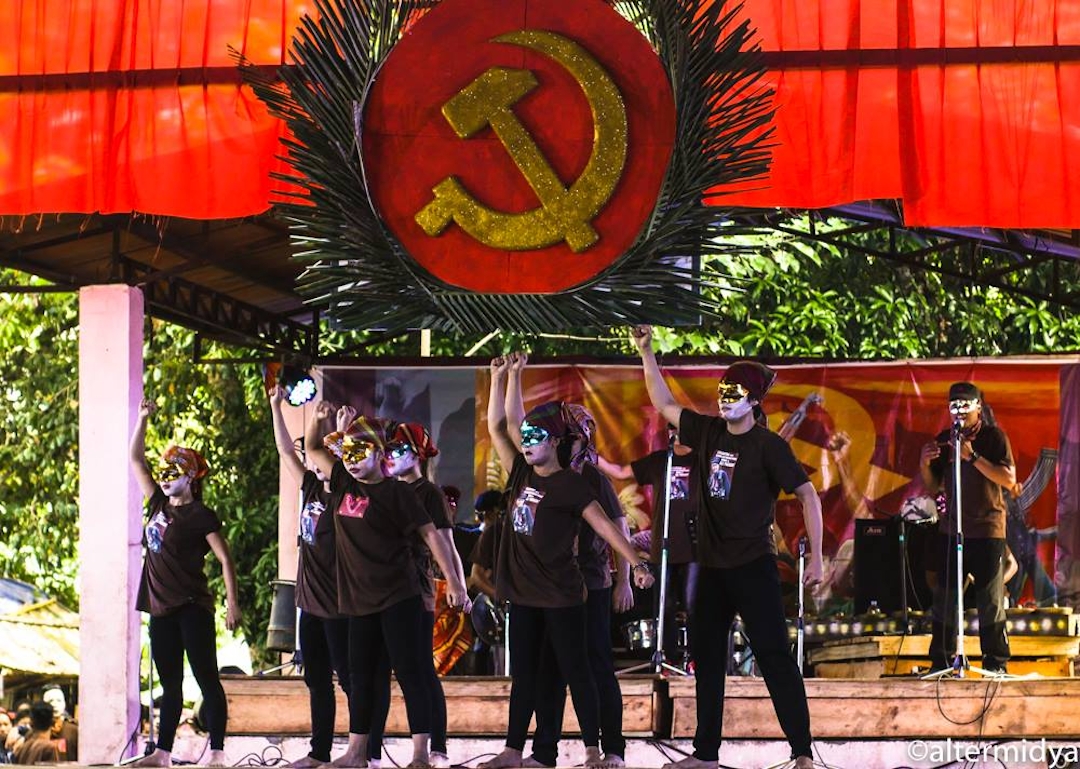
Ka (Comrade) Kathryn, a young NPA combatant in Southern Tagalog who has become the face of a new breed of red fighters. Photo Credit: KODAO Productions
Why you need to know: The war in the Philippines is far from over, explains Michael Beltran
The New People’s Army (NPA) is showing no signs of slowing down. The armed component of the world’s longest-running communist revolution celebrated its 48th anniversary on March 29.
NPA is led by the Communist Party of the Philippines (CPP) and was founded a year after the party in 1969. Since then, each president has vowed to quash the rebel forces while the CPP has attributed a nearly 50-year long struggle to support peasants.
The National Democratic Front (NDF), CPP’s political alliance, has been engaged in peace negotiations with the government since the start of President Rodrigo Duterte’s term. Despite some hurdles along the way, the talks have reached unprecedented milestones. The main mission of the talks is to resolve the armed conflict — namely the widespread poverty and injustice.
There have been temporary ceasefires during the talks but armed encounters between the rebels and military have persisted. Being in the spotlight, the NPA has had a unique opportunity to further open up to the public, and public figures are responding. Environment Secretary Gina Lopez said last week that she “loved the NPA, ” which she described as “nice people” that she wanted to work with to safeguard environmental concerns.
According to the CPP, guerrilla fronts have been established in most of the country’s rural areas since 1977, a vast majority of the landscape. By 2013, CPP leadership had declared that the NPA operates in 71 out of 81 provinces.
This number doesn’t come as a surprise. It’s not uncommon for folks in far-flung areas to occasionally share tales of meeting the armed revolutionaries.
NPA spokesperson Ka (the Filipino prefix for “comrade”) Oris has said that the number of tactical offensives increases by the hundreds each year. This is especially true in Mindanao — the southernmost region of the country and a perceived stronghold for the rebels.
Communist parties and revolutionary armies are certainly not passé in the Philippines. A hundred years after Vladimir Lenin led the October Revolution, an armed struggle for liberation and establishing socialism is still very much a thing of the present in the Philippines. Here are five reasons why:
1. Persistent reasons to carry on the fight
Aside from the chokehold American imperialism has on the country, feudalism reigns over the nation’s countryside. There are 13,000 hectares of agricultural land but seven out of 10 farmers are without any land of their own.
Landlordism in its barest and most backward stature is very much at the heart of these feudal systems. I have seen farmers harvesting only once a year, living off sweet potatoes the rest of the time. Their farming tools and methods have been inherited from the Spanish era 400 years ago and do not produce nearly enough for them to avoid hunger.
I have seen sacks of rice and vegetables placed down in front of landlords by tenants who in return receive what amounts to spare change. I have seen flowers, fruits and even children offered in a festive manner to landlords as forced tribute. Land monopolies, landlessness and a destitute peasant class have crystallized the conditions for armed uprisings.
The nation has shown increasingly alarming displays of social inequality. According to the World Bank in 2015, the Philippines has the highest unemployment rate in Southeast Asia. In the last six years, the net worth of the 40 richest Filipino families grew from 14 percent to 24 percent of the GDP, and the total income of the 25 richest individuals in 2016 is equivalent to that of 76 million Filipinos.
It doesn’t take much for marginalized, impoverished and hungry Filipinos to see that “history needs a push.”
2. Strong revolutionary tradition
Contrary to the laid back and hospitable nature of Filipinos, our history is one of constant conflict. Filipinos have been fighting foreign intervention and local elites ever since Magellan arrived in 1521.
Throughout the 300-year Spanish colonial period, more or less 200 revolts of various sizes and aims broke out. The 1986 revolution led by Andres Bonifacio took this a step further by establishing a national network of rebels.
The Spanish were replaced by the American occupation in the early 1900s and early Marxists in the country established the first communist party in 1930. By World War II and the Japanese takeover, the CPP had established an anti-colonial force in the Hukbong Bayan Laban sa Hapon (People’s Anti-Japanese Army), or HUKBALAHAP.
The re-establishment of the CPP in 1968 quickly led to the formation of the NPA a year later. Youngblood of the new CPP took inspiration from the “unfinished revolution” of Bonifacio for national liberation and democracy.

Photo Credit: Boy Bagwis of Pinoy Weekly Full battle gear: Pulang Bagani Battalion kicks off the CPP anniversary in DAVAO.
3. Self-governing in the mountains
One nation, two states — the status of belligerency endorsed by European Parliaments in the 1990s means there are two sovereign entities at war with each other. Essentially, the communists have their own standing army, defined “red areas,” laws, officials and social platforms. The virtual non-existence of any governing body to address concerns of the people coupled with the injustices of feudalism led the CPP to oversee and manage affordable basic services and social systems in the countryside as best it can. Most farmers in these areas identify as part of the People’s Government rather than the one headed from the Presidential Palace in Manila. These are also places where the people make the rules and the government follows.
A few years back, the CPP released a video showcasing a municipality run by the rebels holding an independent election for their town's leader outside of the Philippine government’s mandate.
Areas managed by people's governments over the years have also built social structures to facilitate everyday concerns. Ways on how to improve irrigation are carried out along with increasing food production and security. Literacy programs are also part of the NPA’s tasks while the health and marriage of people are taken into account as well.
Other than the Vatican, the Republic of the Philippines is the only state in the world where divorce is illegal. But the revolutionary movement has its own marriage guidelines that include same-sex unions and divorce.
4. A wealth of supporters
Despite the cancelation of the ceasefire between the NPA and the Duterte administration in February, the two parties say that negotiations can continue even during times of combat. But the truce was still in effect Dec. 26, 2016 — Mao Zedong’s (毛澤東) birthday and the anniversary of the CPP. A communist Christmas if you will, as the occasion was widely and seriously marked in guerrilla fronts nationwide.
During the latest anniversary celebration, the CPP invited the public and their sympathizers to the guerrilla zones, especially a particular one in Mindanao where a grand commemoration would be held. Government officials, nuns and priests, scholars, foreign delegates, artists and farmers were among the 15,000-strong crowd, enjoying music, dance and a festive atmosphere to the theme “People’s War is for People’s Peace.”
This was just one of the guerrilla fronts; another notable one took place in Southern Tagalog, not so far from Manila and drew in over 1,000 people. Ka Diego, a spokesman for the region, and Ka Kathryn, a vocal and iconic persona, called on young people to join the NPA and led the celebrations.

Photo Credit: Altermidya 15,000 attended last year's CPP anniversary on Dec. 26.
5. The Communist Party doesn't stop
Numerous tactical offensives since the start of the year have punished military troops of the government. It has become a common news story to feature NPA units having conducted raids on enemy camps, burning the heavy equipment of maligned large-scale mining companies and so on.
In the cities, NPA members and supporters organized parades of masked men calling on the people to join the revolution. Two parades were held in the past month — unusually frequent for an underground and illegal organization.
Every president since the inception of the NPA has had their own counter-insurgency program with the promise of eradicating the guerrillas. None have really come close to wiping out the movement. The increased rebel activity and capacity to fight over the past few years affirm this. Just one provincial formation of the NPA in northeastern Mindanao successfully launched 181 strikes and operations against military troops.
Winning battles is one thing but the red fighters are apparently even winning the hearts and minds of some of their enemies. Two prisoners of war held by the NPA for three months were recently freed and their reaction was surprising to many. They thanked the guerrillas “for giving us a second chance at life.” “You did not hurt us and freed us without a single scratch,” they said.

Photo Credit: Altermidya
The war is far from over. No doubt the communists know this. At this rate and with both parties at the negotiating table, the tide may finally turn in their favor.
https://international.thenewslens.com/article/67077

Article represents the commie point of view.
ReplyDelete